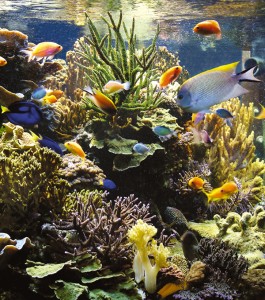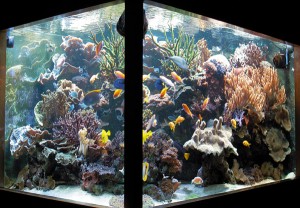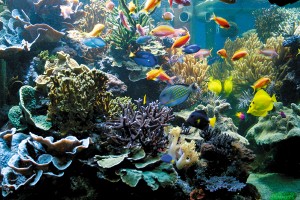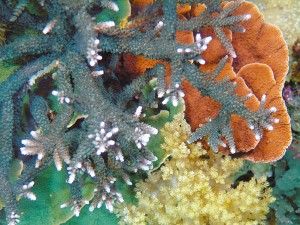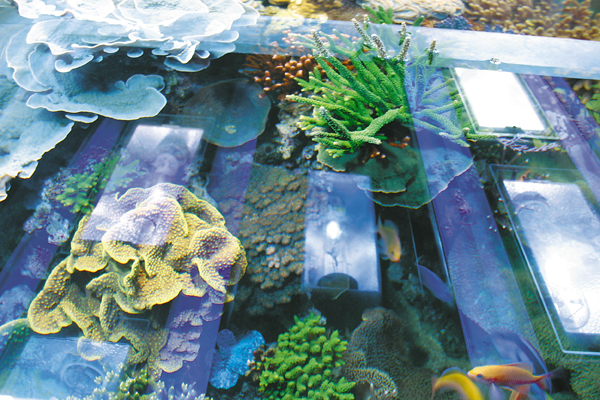European hobbyists have been at the forefront of developing reef aquarium systems for more than 40 years, with German technology featuring prominently in the types of equipment used in most hobbyist high-tech reef tanks. Recently, however, many reef aquarium enthusiasts worldwide have forsaken high-tech methods in favor of far simpler and more natural techniques for maintaining their reef aquariums. One such method is the EcoSystem Filtration method developed by American aquarist, Leng Sy.
Over the past several months, I’ve been busy writing a series of articles for the British reef aquarium magazine, The Best Reef Aquariums in the World. This has taken me not only throughout Europe to evaluate reef aquariums, but also to as far away as Hawaii. Surprisingly, I found that a number of the remarkable reef aquariums I decided to include are run using the Ecosystem filtration methodology, and so I was thrilled when I heard, through the British reef hobbyist grapevine, that a reef aquarium at the headquarters of Underworld Products, in London, was not only well worth my attention, but was also using this system. Not only was it nice to be undertaking my latest piece of reef aquarium investigative journalism closer to my home in England, but it also offered a good opportunity to get down to the bottom of the EcoSystem Filtration phenomenon.
I began my investigation by chatting with Des Ong and Jane Timson, the Ecosystem “experts” at House Underworld, asking them to give me a little information about the history and development of Leng Sy’s method here in England. Des explained that this filtration method was introduced more than five years ago, following the amazing success with EcoSystem-filtered reef aquariums in the United States. The full range of EcoSystem products became available from Underworld shortly thereafter.
The Ecosystem method became an instant success in England, appealing mainly to a new generation of reef hobbyists setting up their first reef aquariums. This success has continued, and there are now an increasing number of reef aquarists who are converting their reef aquariums from, say, Berlin-style tanks to those using the Ecosystem method. The trend has continued and there are now quite a number of “hybrid” systems that combine Ecosystem filtration with more conventional methods.
I asked Des what he considered to be the main appeal of the Ecosystem method and he commented that many hobbyists like the concept of using natural elements as apposed to lots of gadgetry. Of course, the primary mechanical element eliminated with the Ecosystem method is the protein skimmer. Unfortunately, the heavy skimming that is part of more traditional filtration methodologies removes beneficial elements, such as calcium, strontium, iodine and molybdenum plus various trace elements, from the system, and regular water changes and dosing with a range of trace element additives form an essential part of tank management when using this approach. Heavy skimming also leads to a lack of plankton-like material in the water and regular dosing with live phytoplankton cultures is also often required. The great success of the Ecosystem method is that the detrimental effects caused by skimming are avoided and the aquarium water reflects, more closely, the natural components that are found in the waters surrounding natural reefs.
At the heart of the system is a mud filtration tank located below the aquarium. It contains Ecosystem Miracle Mud®, which has been fortified with minerals and essential trace elements, and also functions as a refugium for propagating Caulerpa algae. The algae are frequently pruned. The 24/7 lighting stabilizes the pH at night and prevents a breakdown of the algal population.
The aquarium at Underworld is quite interesting and successfully illustrates how a reef tank with minimal equipment can work. Its population of numerous healthy corals with their polyps fully extended is kept company by gorgeous reef fishes, such as the yellow tang (Zebrasoma flavescens) or delicate anthias species like the bicolor anthias (Pseudanthias bicolor). Des told me that four years ago, when the tank was being set up, there were some initial problems with shrimp feeding on corals and other invertebrates, which led to bacterial infections.
Iodine baths and capturing the crustaceans in commercially available traps have, however, solved the problem, and the tank has developed beautifully since then. The corals grow extremely rapidly, with small fragments of Acropora and other coral genera soon developing into large colonies. The reason for this exceptional growth rate is most likely the increased availability of plankton, bacteria and other micro-organisms in the system — after all, there is no skimming and no mechanical filtration. The increased density of micro-organisms not only has a positive effect on the corals, but also on other invertebrates, such as sponges, colony-forming tunicates and tubeworms. The larvae of these (and other) filter feeders are continuously washed from the mud filter refugium into the main aquarium where they are able to settle, unlike in traditional aquariums, from which they are filtered and skimmed out.
But it is really the dense (and well fed) fish population that best illustrates the robustness of the system. Des explains that even with the mud filtration method a balance between nutrient import and export must be achieved. Otherwise, as in any other reef aquarium system, algal growth would explode. The solution is the algae “forest” in the mud filter — frequent pruning exports nutrients. This tank is a prime example of how simple a successful and robust reef aquarium system can be.
Les Holliday, England
Aquarium Specifications
Size:
380-gallon (1470 liter) main display aquarium, 60 x 39 x 39 inches (150 x 100 x 100 centimeters), with a 78-gallon mud filter/sump, 39 x 33 x 20 inches (100 x 84 x 50 centimeters) with a water level around 14 inches (36 centimeters)
Invertebrates:
The mix of corals in the aquarium is around 90-percent hard corals and 10-percent soft corals.
Hexacorallia: Small-polyped stony corals include Acropora spp., Echinopora lamellosa, Hydnophora pilosa, Merulina sp., Montipora capricornis and M. digitata, among other Montipora spp., Pavona cactus, Pocillipora damicornis, Psammocora sp., Seriatopora caliendrum, S. hytrix, Turbinaria peltata, T. reniformis. Large-polyped stony corals: Blastomussa wellsi, Caulastrea furcata, Duncanopsammia axifuga, Fungia sp., Goniopora sp., Lobophyllia hemprichii, Platygyra pini. Other Hexacorallia: Discosoma and Rhodactis species, plus various yellow mushroom anemones and Zoanthus spp.
Octocorallia: Heliopora coerulea, Pachyclavularia violacea, Sinularia asterolobata, Coelogorgia spp., Pseudaxinella sp., Pseudoptergorgia sp., Sarcophyton sp., Xenia sp.
Other Invertebrates: Lsymata amboinensis shrimp, Tridacna maxima giant clam and numerous sponges
Fish:
Acanthurus lineatus, Zebrasoma flavescens, Z. xanthurum, anthias, including Pseudanthias bicolor and P. squamipinnis, Chelmon rostratus, Genicanthus melanospilos, Chromis viridis, Gramma loreto
Decor:
Approximately 25 percent of the volume of the aquarium is filled with live rock
Lighting:
Main aquarium: Five 400-watt (W) metal halide lamps in a mix of 14,000 and 20,000 Kelvin (K), on eight hours per day, four 30 W standard output actinic fluorescent tubes, 14 inches (35 centimeters) above the aquarium, on 10 hours per day
Refugium: One 150-watt metal halide lamp on 24 hours per day
Water maintenance:
Change 25 to 30 percent of the water every six to eight weeks, with reverse osmosis water and Instant Ocean or Reef Crystals salt mix
Water circulation:
Two pumps rated at 2338 gallons per hour (gal/h) (9000 liters per hour; l/h) used for filter turnover; three pumps rated at 1558 gal/h (6000 l/h) are used solely for water movement
Equipment:
EcoSystem Filter with Miracle Mud®, calcium reactor with periodic dosing of calcium chloride, no protein skimmer. Occasional use of Phos Ban and polyfilter adsorption pads for phosphate (PO4) removal
Water parameters:
Temperature: 72 to 75 degrees Fahrenheit (22 to 24 degrees Celsius)
Salinity/specific gravity: 30 parts per thousand (ppt), 1.022
pH: 8.0 to 8.3
Nitrate: Unmeasurable using commercial aquarium test kit
Phosphate: 0.2 milligrams per liter (mg/l)
Calcium: 345 to 390 mg/l
Owner:
Underworld Ltd., England


